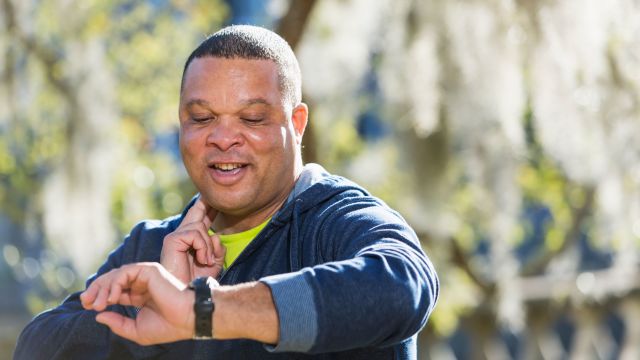Updated on July 24, 2023.
Want a healthier heart? It’s time to get moving.
Physical activity is vital to your well-being and it’s particularly crucial for your cardiovascular health. “The heart is a muscle and we’re trying to condition that muscle to improve blood flow to the brain and the skeletal muscles,” says James A. Smith, DO, a cardiologist with Wesley Medical Center in Wichita, Kansas.
For substantial health benefits, most adults should aim for at least 150 minutes of moderate cardiovascular exercise or 75 minutes of vigorous cardiovascular exercise each week, according to the Physical Activity Guidelines set forth by the United States government. Ideally, these sessions should be spread out over several days, instead of being jam-packed into one or two days.
But what do “moderate” and “vigorous” mean? The answer lies with your heart rate.
Max and target heart rates
To begin to understand heart rate, the first thing you’ll need to do is some simple math. Take your age and subtract it from 220. That’s an estimate of your maximum heart rate, which is roughly the top limit of what your heart can handle when performing physical activity. There are other ways to find this number, but this method is the easiest. According to the calculation, a 50-year-old, for example, would have a maximum rate of about 170 beats per minute.
Your target heart rate during exercise is a percentage of your maximum heart rate.
- For moderate exercise, your target should be 50 to 70 percent of your maximum heart rate. If you are 50 years old, that works out to 85 to 119 beats per minute.
- For vigorous exercise, 70 to 85 percent is a good target. If you are 50 years old, that works out to 119 to 144.5 beats per minute.
Talk to your healthcare provider about the ideal target heart rate for you, especially if you’re considering a new exercise regimen. For many people during exercise, Dr. Smith says, “you should be breathing heavily and have a light sweat going.”
Exercise recommendations
Activities that get your heart rate up and increase your breathing rate are called aerobic exercises. These include:
- Brisk walking
- Jogging
- Running
- Biking
- Hiking
- Swimming
- Dancing
All aerobic exercises count toward hitting those 75- and 150-minute guidelines.
The weekly recommended amount of physical activity can be achieved more efficiently with interval training. Often called high-intensity interval training (HIIT), this type of workout involves increasing your pace and heart rate for a brief period, then dialing the energy back down for a period of lighter activity known as active rest. For example, if you’re on an elliptical trainer, you would move with full effort for 15 or 30 seconds every quarter mile, then reduce your speed until the next quarter mile.
“You’re creating hypermetabolic conditions,” says Smith. “You’re breathing fast, your heart is beating fast and the body is clearing waste products fast.”
Research shows that HIIT can improve health, especially in people who are overweight or obese. “For people who don’t have an hour to work out, you can accomplish a lot through interval training,” Smith says.
If high intensity sounds intimidating, don’t discount something as simple as walking. Strolling briskly on a regular basis can help you lose weight, reduce your risk of heart disease and diabetes, slow mental decline, stave off stress, and help you sleep more soundly. Start with a 15-minute walk and then track your steps every day so you can set goals to increase your time and mileage. Sharecare (available on iOS and Android) has a built-in steps tracker. Just keep your phone on you and get moving, keeping your optimal heart rate in mind.







